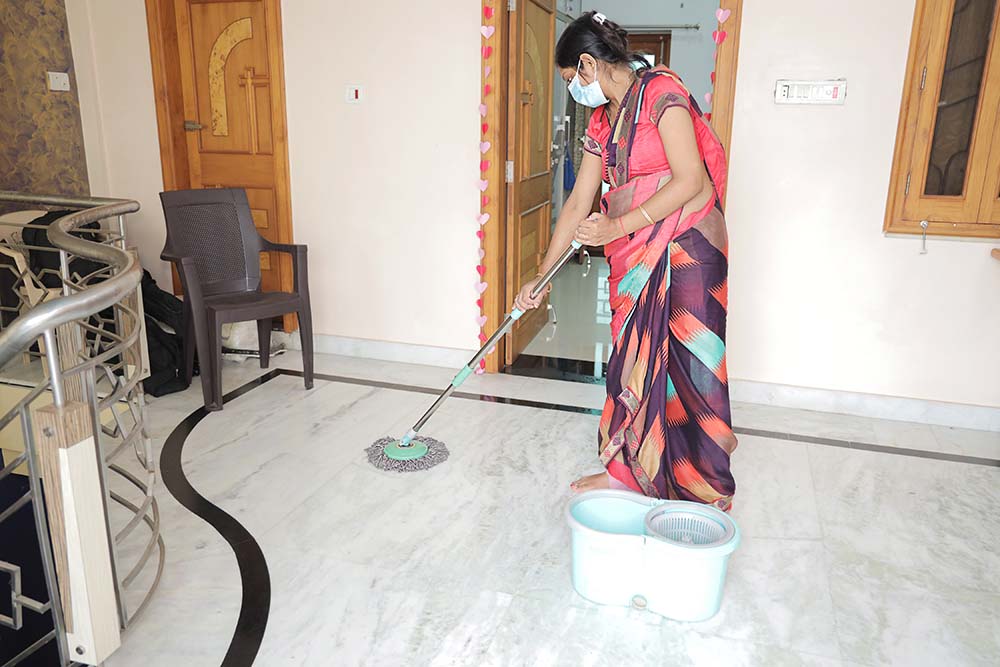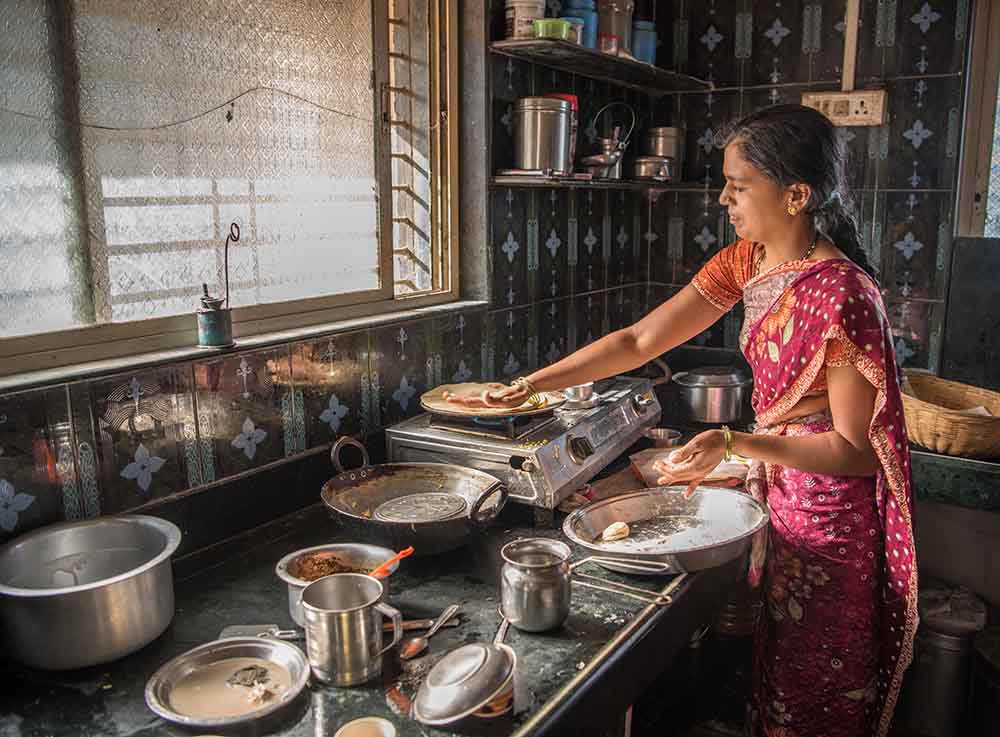Every morning, she wakes you up by ringing the doorbell. You may or may not be an early riser, but she certainly has to be to ensure your household functions well. She sweeps and wipes the floor, she cooks and cleans the kitchen, she cleans the bathrooms, she dusts the entire house, she cares for your kids in both your presence and absence, and she cares for your elderly parents—maybe even your pets. You might call her a cook, a maid, a nanny or a house help, but what she really is within the larger spectrum of the nation’s labour force, is a domestic worker.
The tradition in Indian households during festivals is to offer all domestic workers something special. This could be a bonus, new clothes, sweets and food. However, the fact is that while these might please your domestic worker, there is something more long-lasting, beneficial and truly empowering that you can do. You could help your domestic worker, especially woman domestic worker, gain financial literacy so that they can manage their earnings both in the long- and the short-term. Given that we all wish and pray for the presence of goddess Lakshmi during Diwali, this financial literacy will truly empower your domestic worker. Read on to find out more.
Domestic Workers: Global And Indian Estimates
The International Labour Organisation (ILO) describes domestic workers as “those workers who perform work in or for a private household or households. They provide direct and indirect care services, and as such are key members of the care economy.” Your domestic worker may be:
• A full-time worker
• A part-time worker
• A live-out worker
• A live-in worker
They may perform duties like cleaning the house, cooking, washing clothes, child care, elderly care, pet care, driving or gardening. No matter what they do, the fact is that your household functions smoothly because of them.
The ILO also points out that most domestic workers around the world, and especially in developing economies, are considered to be a part of the informal economy. Of the estimated 75.6 million domestic workers globally, 76.2 per cent are woman. The official estimate for Indian domestic workers is 4.75 million, of whom three million are women. However, the ILO also states these numbers might be a severe underestimation, and the true estimation might be anywhere between 20 million to 80 million domestic workers.

Domestic Workers’ Rights and Literacy
Despite the fact that they make up such a huge chunk of the population and the economy, domestic workers rarely have access to any rights and protection. Their working conditions are usually strenuous, include long hours, and the average monthly wages are unstructured and dependent on regional variations. According to a study titled Platforms, Power & Politics: Perspectives from Domestic & Care Work In India, by the Centre for Internet and Society in collaboration with the Domestic Workers Rights Union, there are many intersections that shape the rights and financial literacy of these domestic workers in the Indian scenario. Not only are most domestic workers women, but they are also usually from “marginalised intersections” that add to their access to rights and education in any form.
So, apart from being gendered, domestic work in India is also stratified along caste and class lines. This leads to the undervaluation of the occupation even further. Add to this the notion that domestic work is mostly categorised as “unskilled labour” or “semi-skilled labour”, and the entire population of women domestic workers goes further down the hierarchy of labour rights in India. The study notes that even though the digital revolution has led to the emergence of placement agencies that assist these women in accessing good employment opportunities with basic worker rights, these are only limited to urban centres. Unless empowered with financial literacy, it is therefore difficult for women domestic workers to transition into the formal economy. That’s where you can come in this Diwali.

How To Help Your Domestic Help Become Financially Empowered
While you may already feel you’re doing your bit by paying your domestic help a salary for the services she offers, take a minute to take the above data into account. These prove that despite the fact that you may be paying them the salary they deserve according to a competitive market rate, that rate is not formalised and structured. If you are a working woman, you’d know that your workplace offers a lot more than just a salary by the virtue of being part of a formalised sector—most workplaces offer allowances for home rent and conveyance, paid and unpaid leaves, health insurance for you, your spouse and elderly dependents, etc. Your domestic workers are really disadvantaged because they do not enjoy any of these perks of being in the formal economy.
What’s more, the above data about gender, class and caste also prove that the chances of domestic workers being literate (forget financially savvy) are very low, especially if they are migrant workers from rural India. So, while you might be paying them enough, they might not know how to manage it or invest it to make it grow. Keeping these in mind, here are a few ways you can help your domestic worker become financially aware, literate and empowered.
Help her get identity and address proofs sorted: Whether she wants to open a bank account or access a government benefits scheme, your domestic worker will need identity and address proofs like Aadhaar card, PAN card, voter ID card, ration card, etc. So, help her get those sorted first. While you’re at it, you can also help them get passport-size photos, which is also something most financial and administrative institutions ask for.
Set up a personal savings bank account: Explain to her how setting up a savings account at a bank can not only help her accrue interest on her deposit, while also ensuring that she will be able to get basic banking facilities like personal loans, home loans, vehicle loans, education loans for children, etc. Setting up a bank account can also open new avenues of opportunities, as you do need one to access small business loans too. If accessing a private bank’s services is difficult for her, you can also share details of the Pradhan Mantri Jan Dhan Yojana (PMJDY) savings account which not only requires very little documentation, but also has overdraft facilities for emergencies.
Get health insurance for them: The COVID-19 pandemic has taught all of us that having health insurance is not a privilege, but a necessity in current times. Sudden and unpredictable illnesses can drain financial resources like very little else can, and this fact is as true for your domestic help as it is for you. So, help her enrol for the Rashtriya Swasthya Bima Yojana (RSBY)—the Indian government’s cashless insurance scheme that provides insurance up to ₹30,000 in government-empanelled hospitals. The enrolment requires just ₹30, and the insurance premium is funded by the government. You could also guide them through the new government plans under the National Health Assurance Mission (NHAM).
Explain the benefits of pension and retirement funds: While she might be reluctant to at first—especially if she bears the financial burdens of the house—do discuss retirement, old age and pension schemes with her. Thinking of the long-term is important to secure her financial future. So, help her set up a pension fund which requires low monthly contributions, like the Invest India Micro Pension Services or those provided by government institutions and banks. Even if she contributes a sum of ₹100 per month beginning now, the accumulated sum by the time she turns 60 will be substantial enough.
Teach all about digital finance tools: In urban areas, getting a smartphone with an internet connection is not that difficult, especially if you have your identity proofs in place. So, accessing digital finance tools is something your domestic worker can absolutely do if you help her out in the initial phases. Take her through a financial app or a budget planning app while explaining how each feature can benefit her. You can also start with Her Circle’s financial tracker in the Goals section.